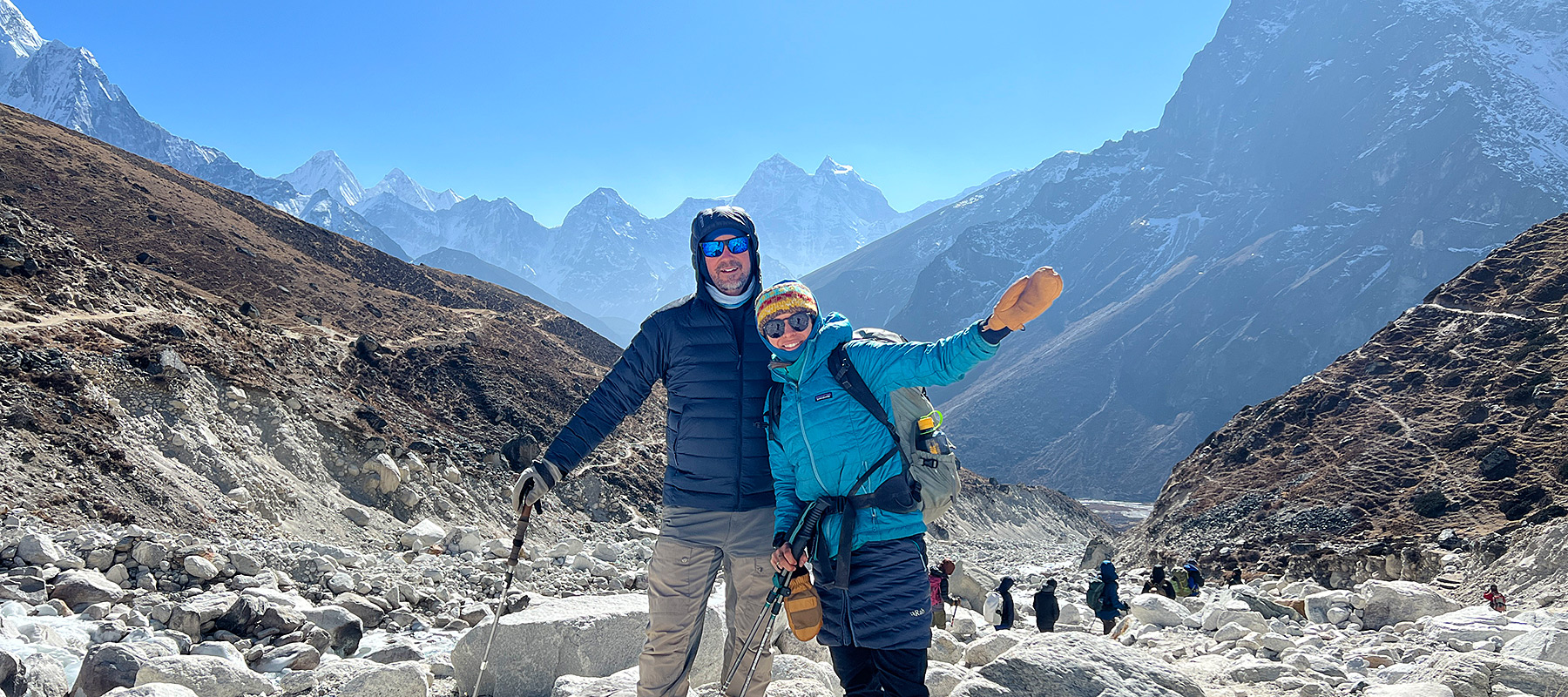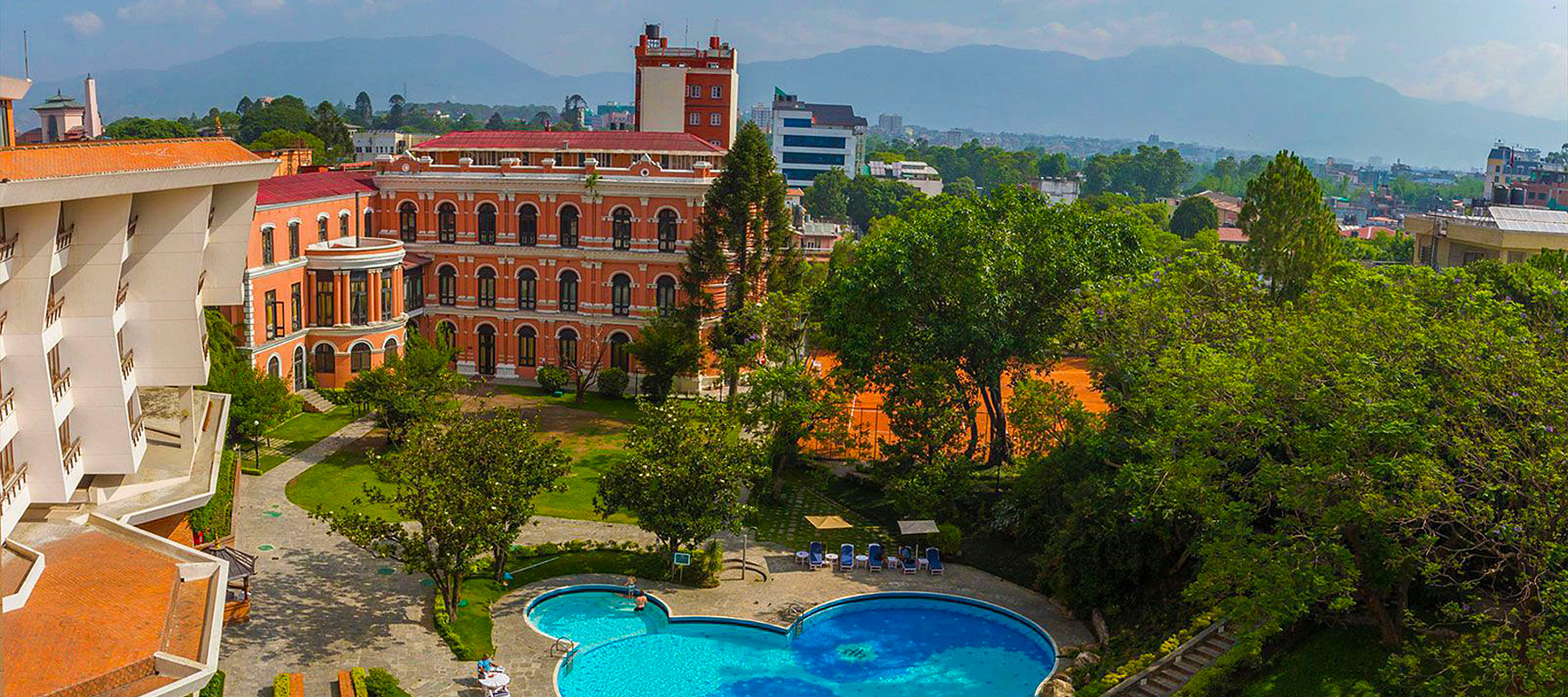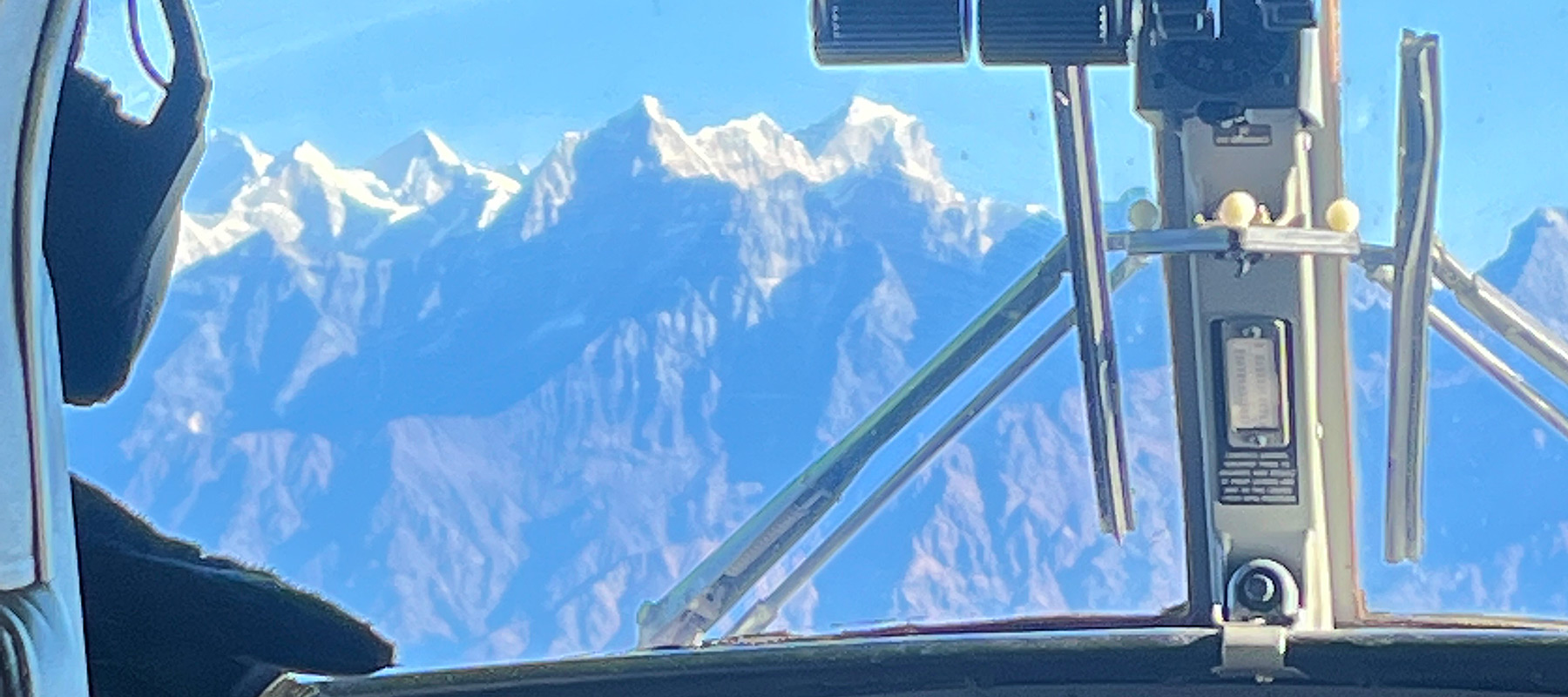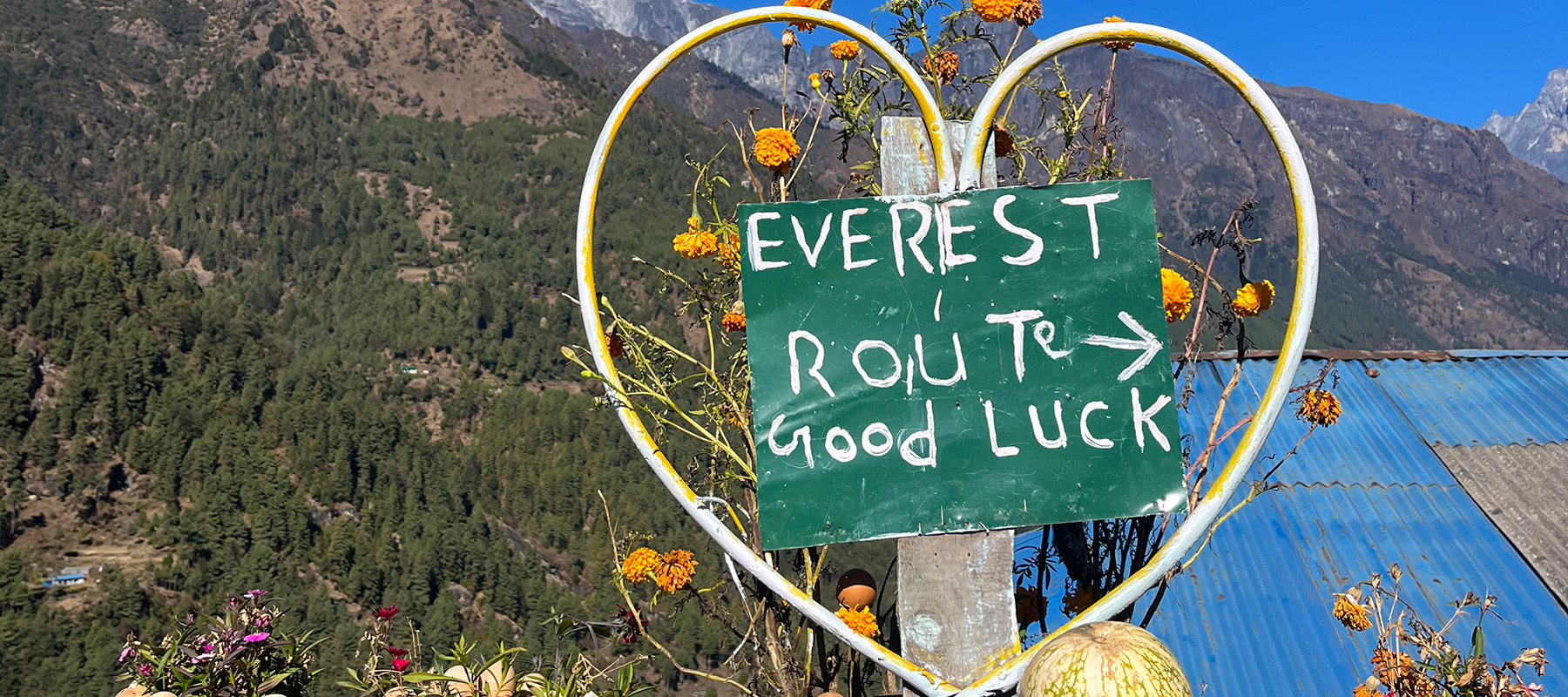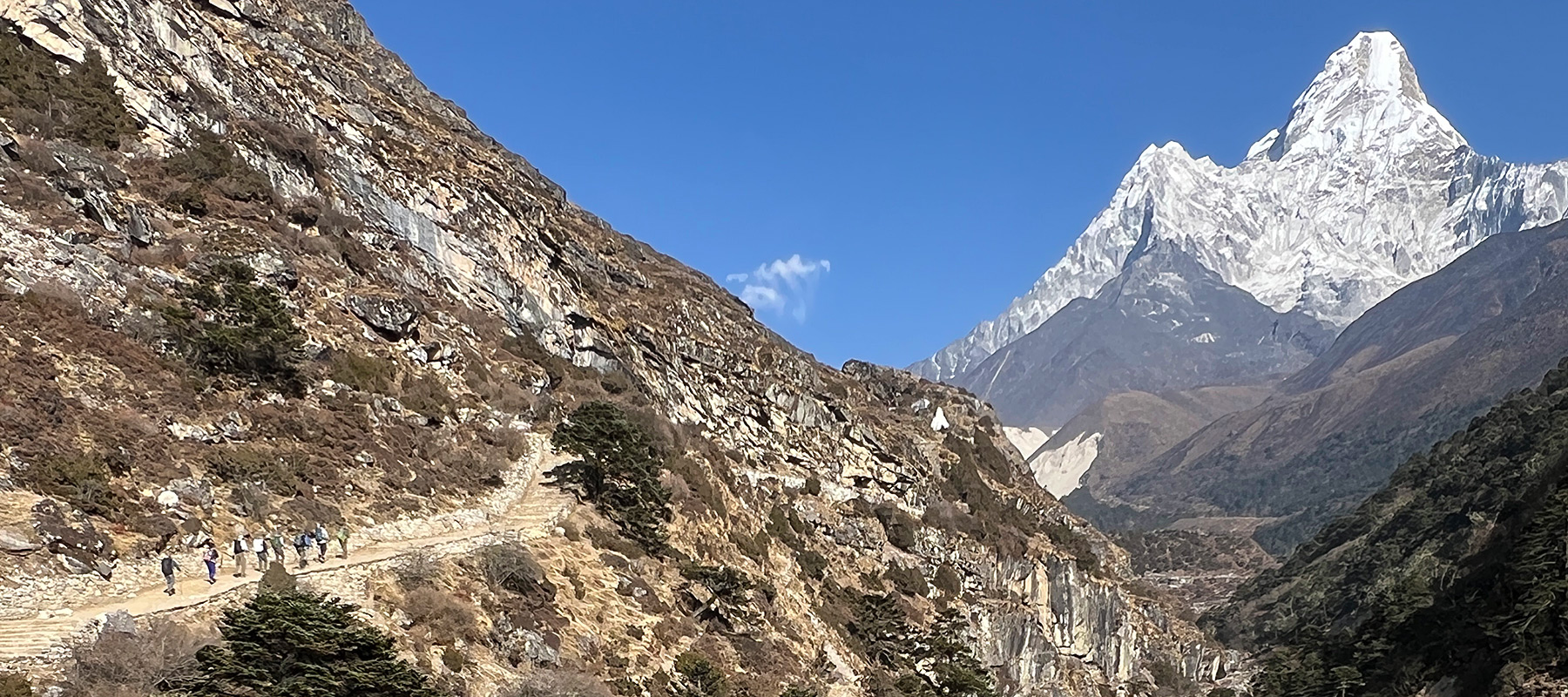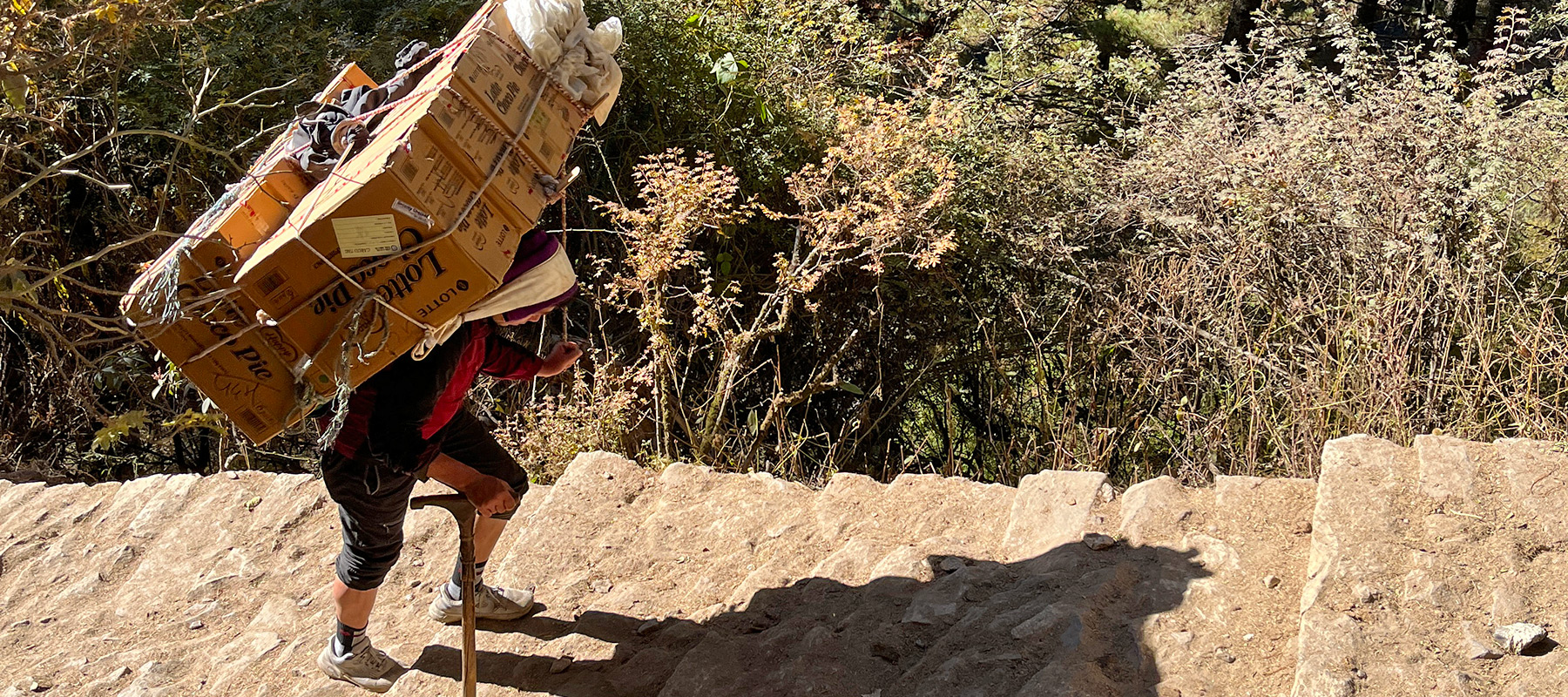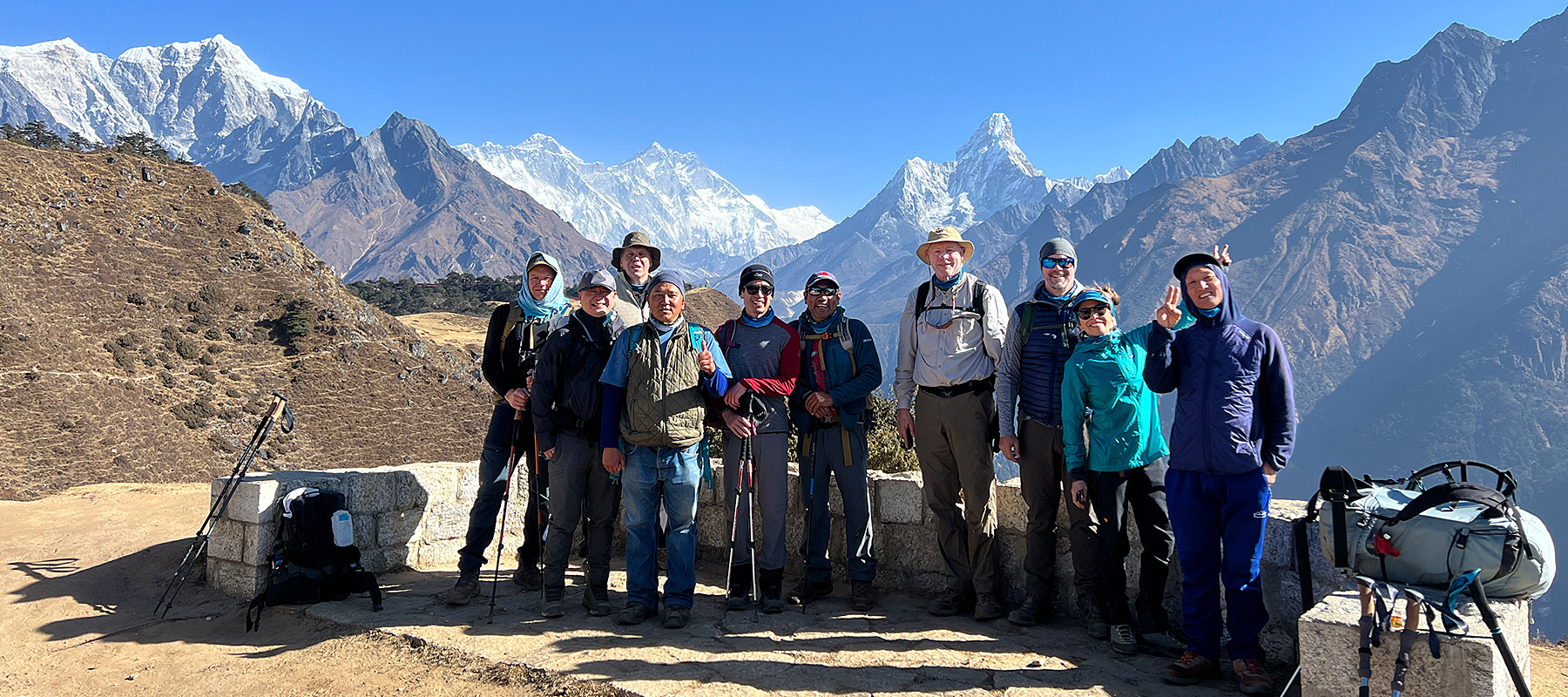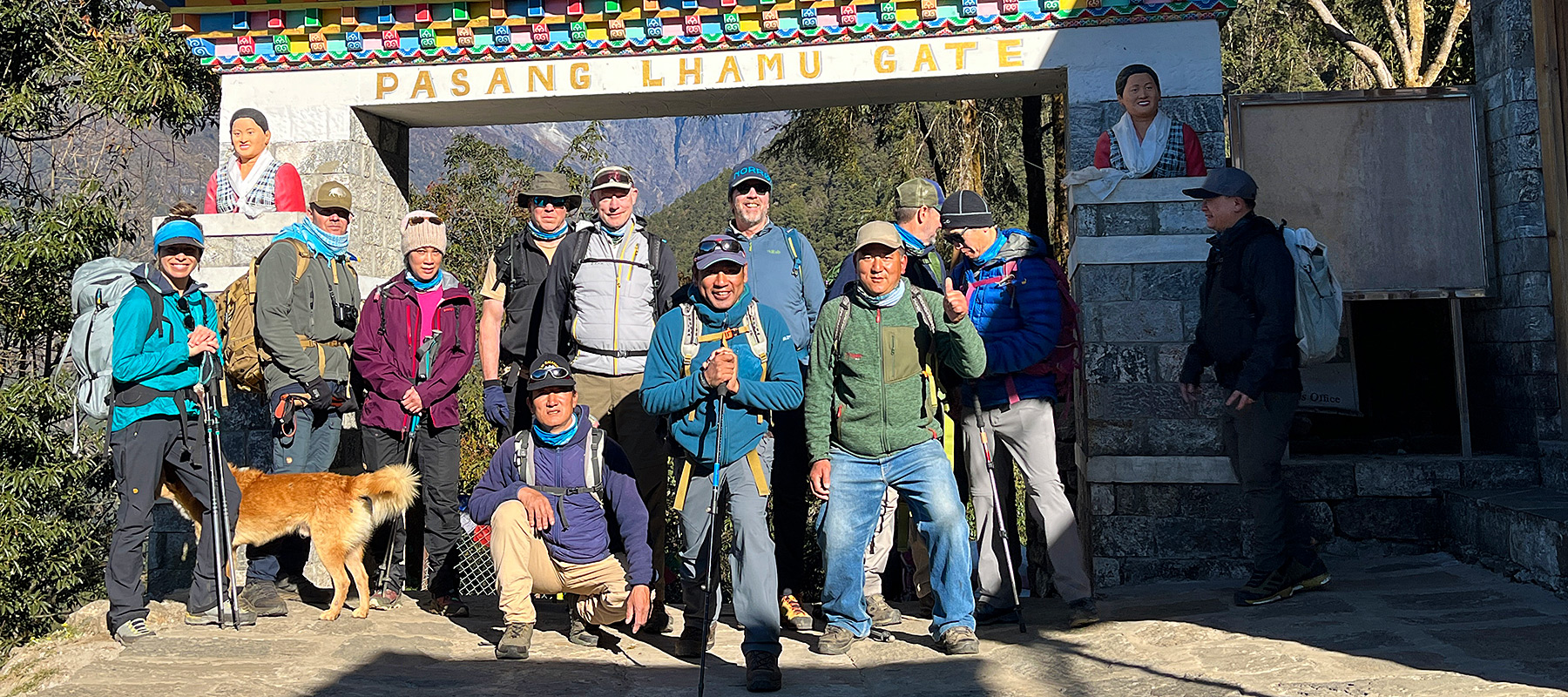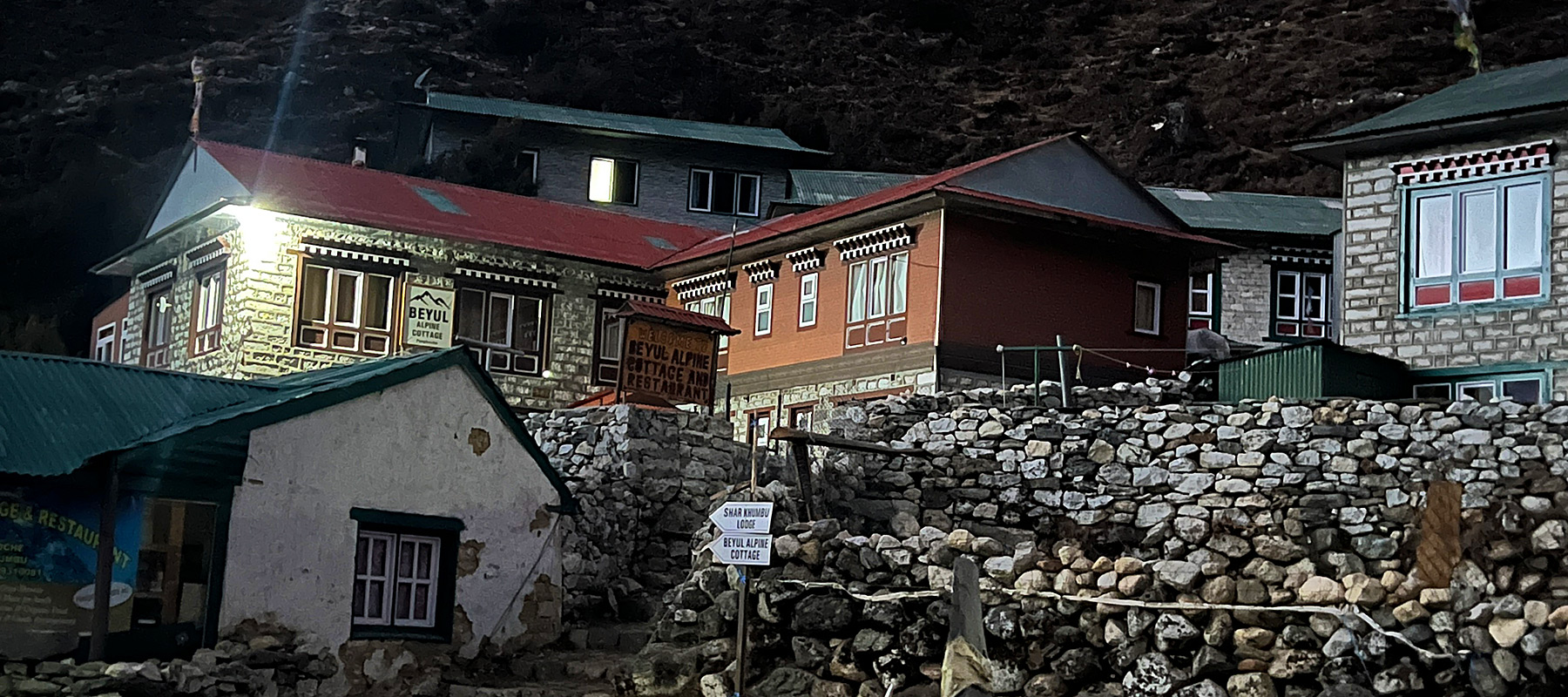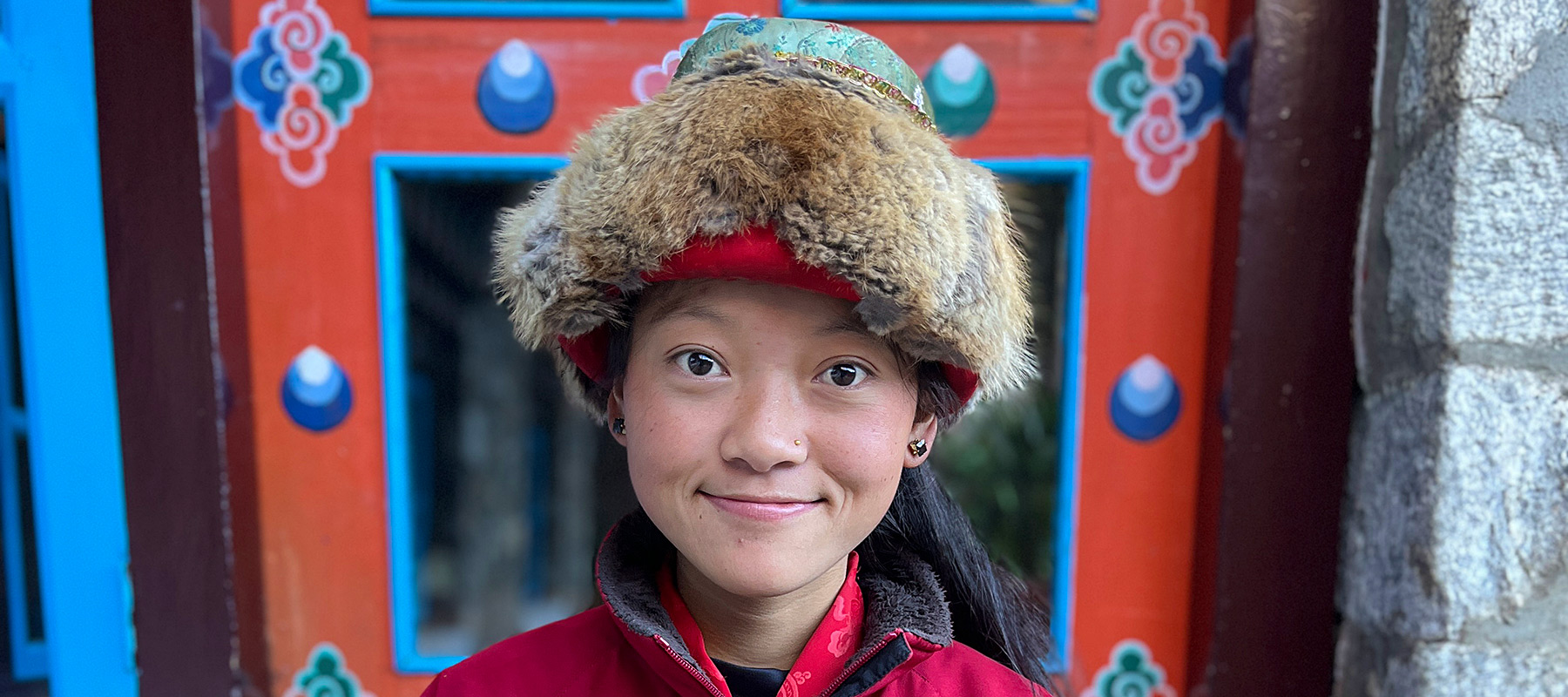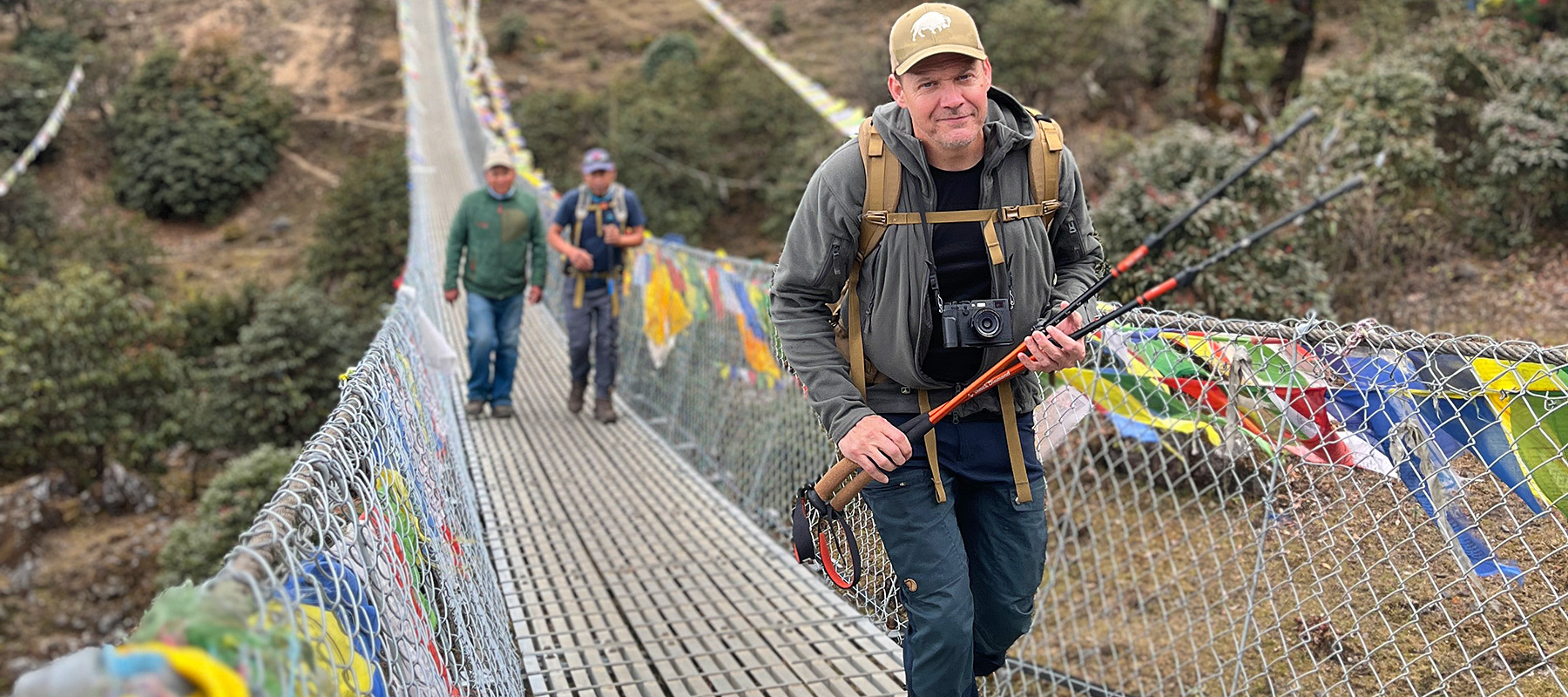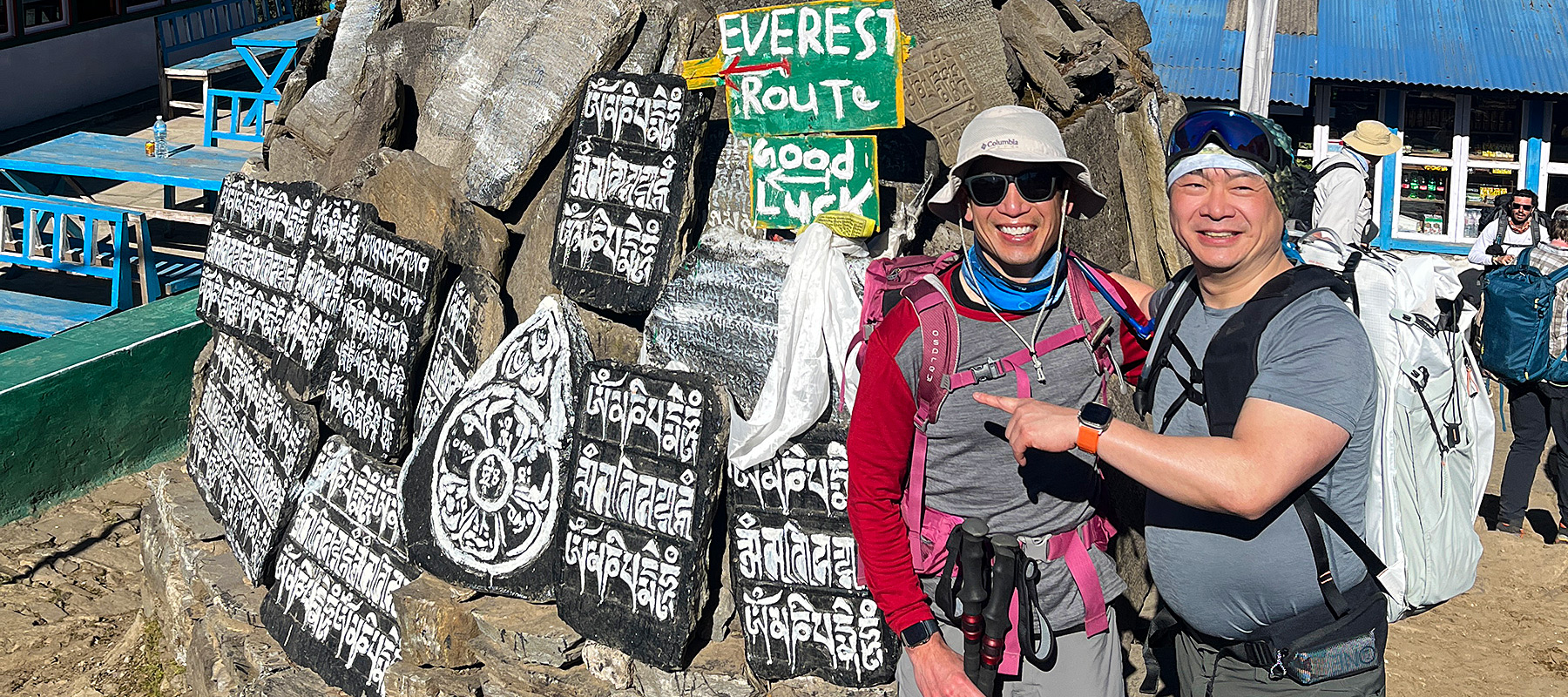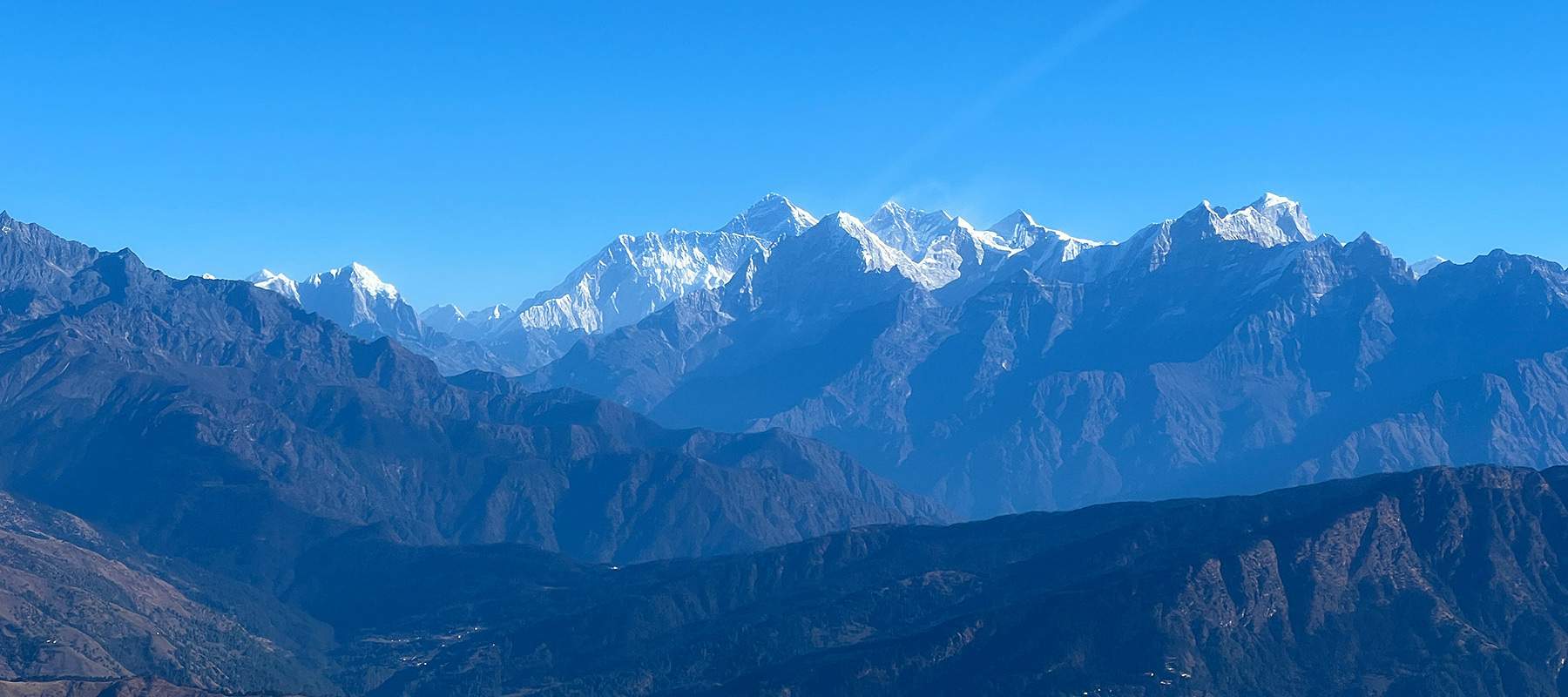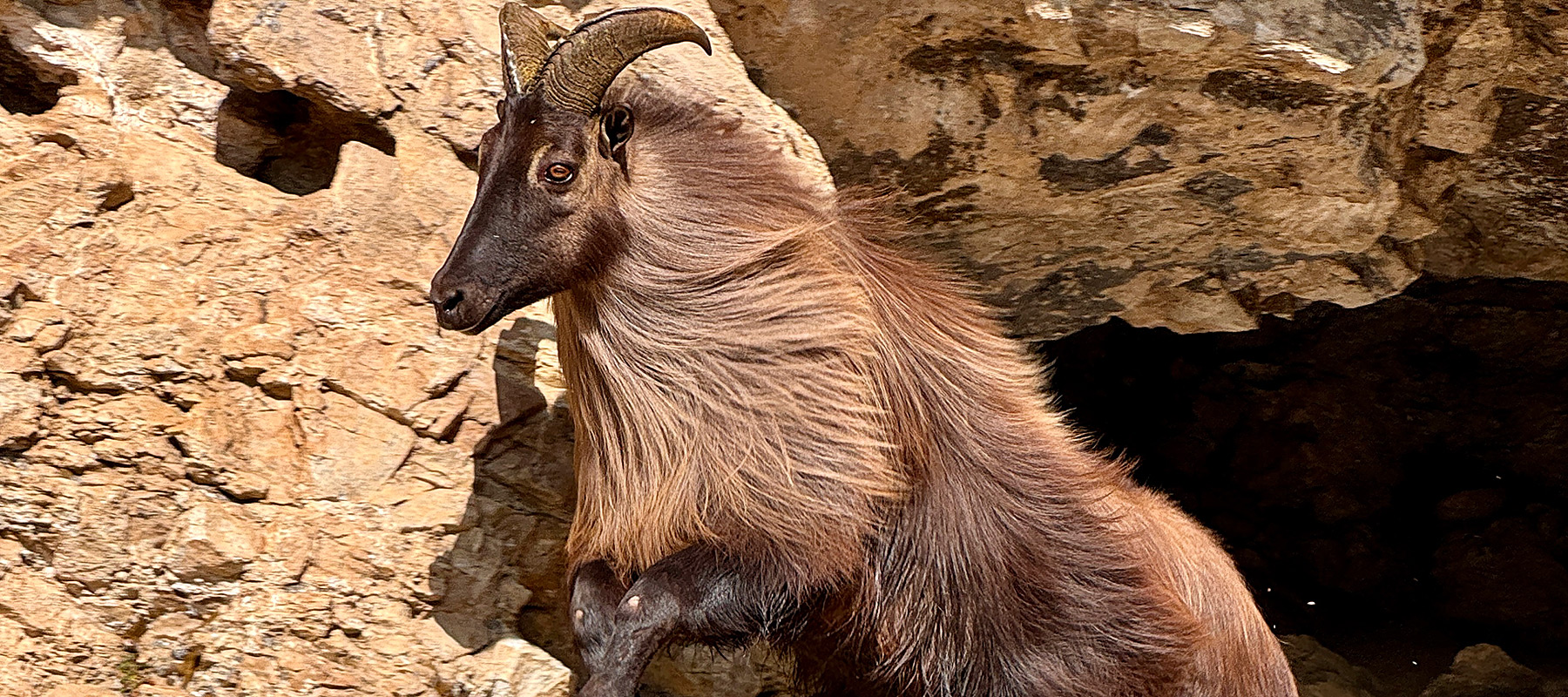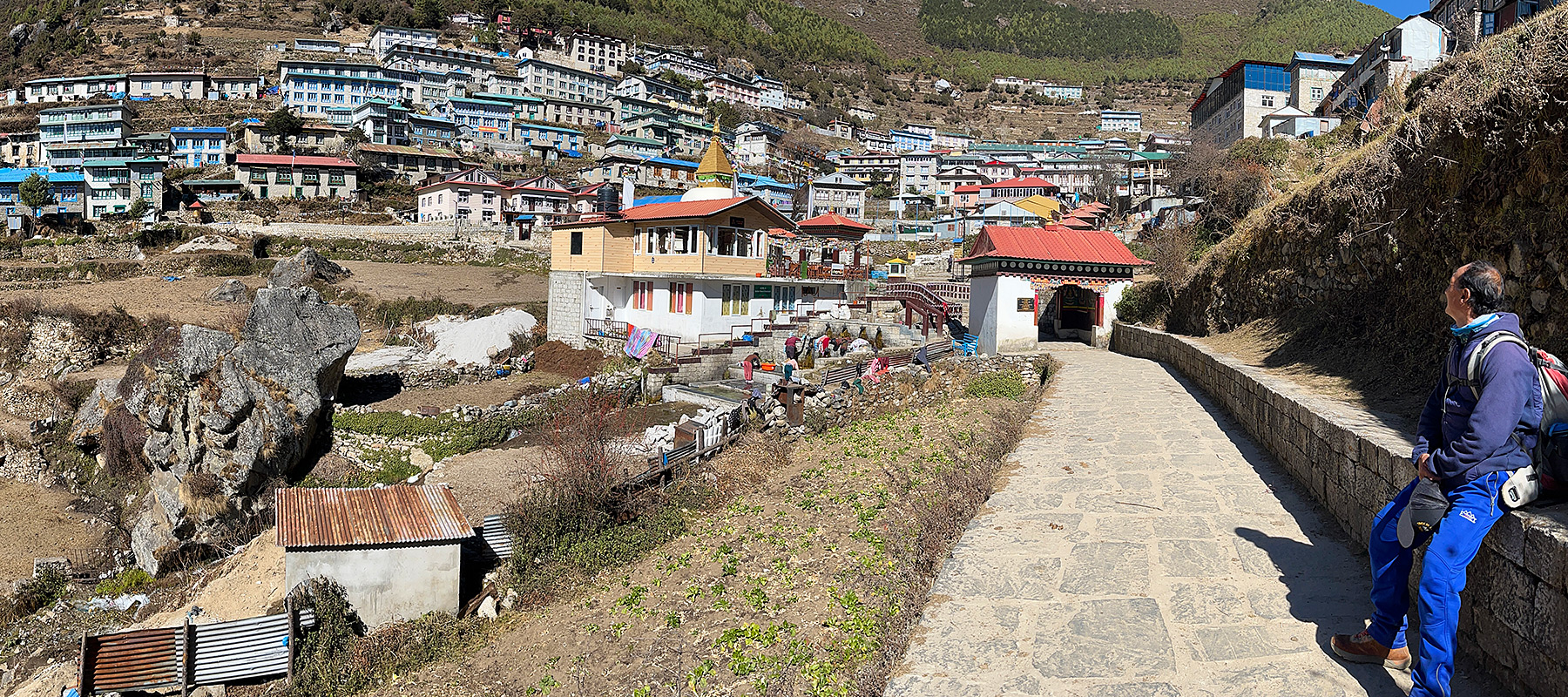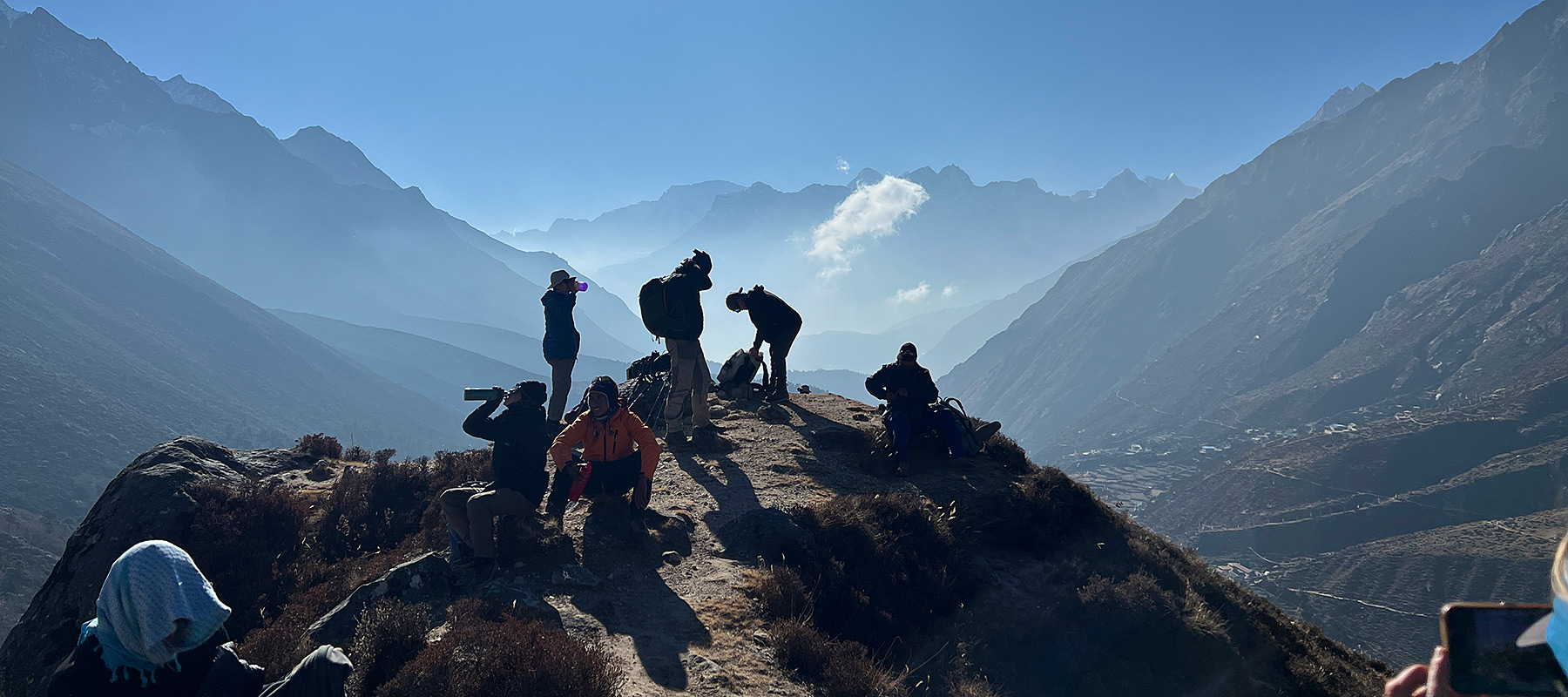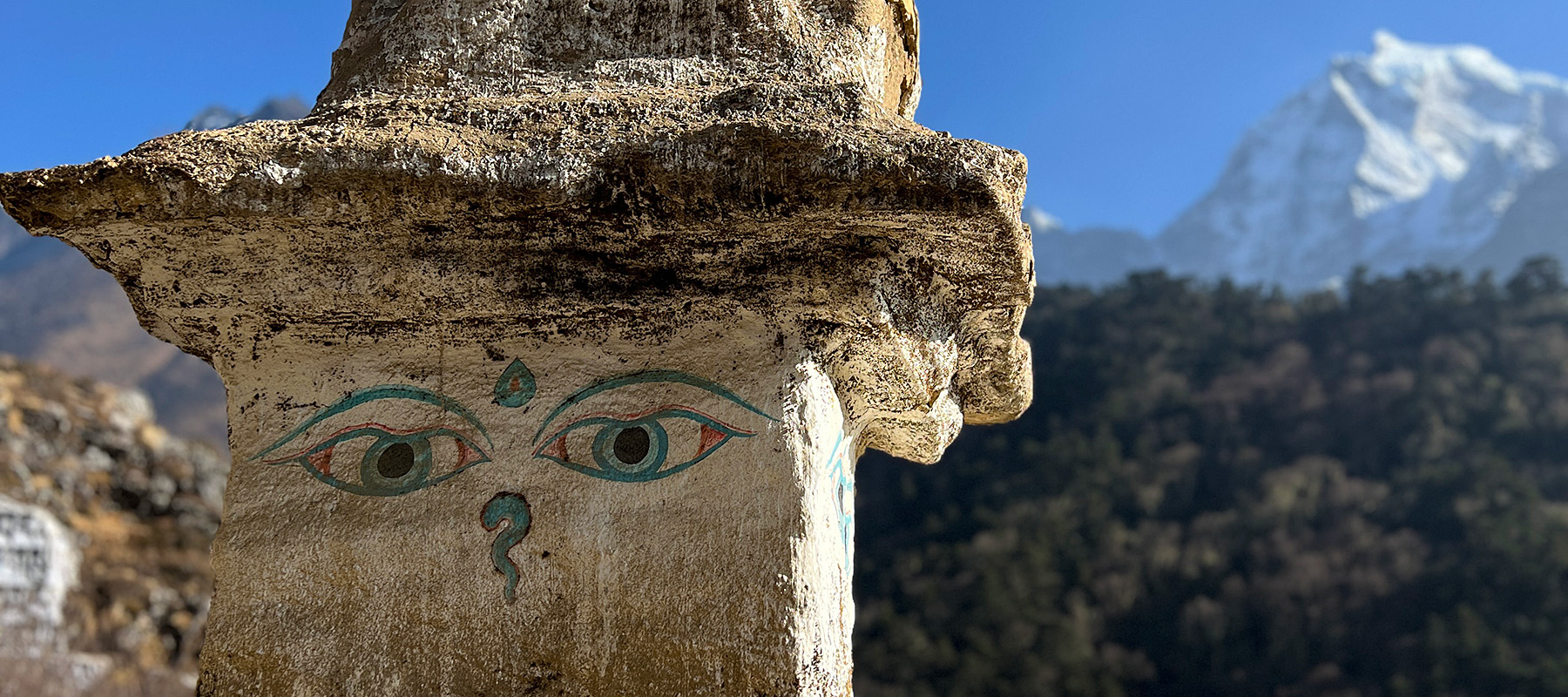16-Day Himalayan Trek
$7995
per person based on double occupancy
2025 Dates:
December 1 – 16, 2025
Deposit: $1000. with balance due 90 days prior Private Room: $1000 Meeting Place: Kathmandu, Nepal Age Range: 16 – 70
Embark on an unforgettable journey to the world’s most iconic mountain with a luxury lodge-to-lodge trek to Everest Base Camp. This meticulously crafted adventure begins in Lukla, where you’ll take a scenic flight into the heart of the Himalayas. Over the next two+ weeks, you’ll traverse breathtaking landscapes, staying in premium lodges that offer comfort and stunning views. As you ascend through charming Sherpa villages and lush valleys, you’ll be treated to gourmet meals, cozy accommodations, and exceptional service, ensuring a truly indulgent trekking experience.
The trek culminates at Everest Base Camp, where you’ll stand in awe of the world’s highest peak. Along the way, you’ll explore ancient monasteries, witness panoramic vistas of snow-capped giants, and immerse yourself in the rich Sherpa culture. With expert guides and porters catering to your every need, you can focus on savoring the adventure and creating memories that will last a lifetime. This luxury trek to Everest Base Camp is the perfect blend of adventure and indulgence, offering an unparalleled way to experience the magic of the Himalayas.
Itinerary at a Glance
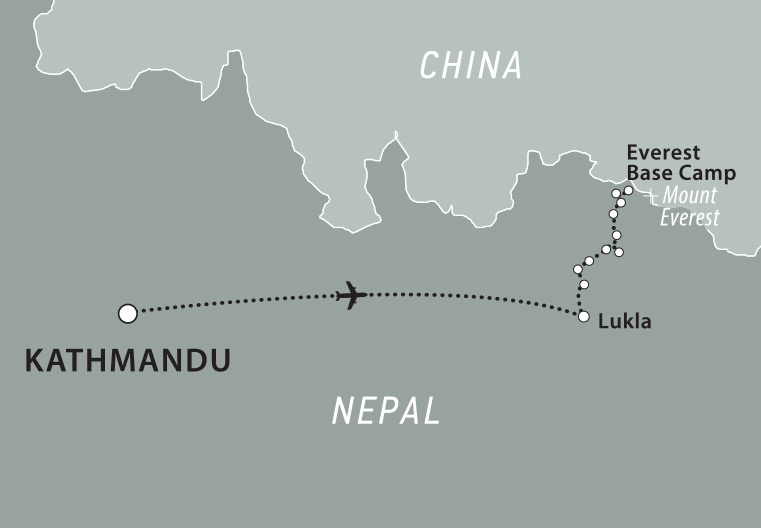
- Arrive Kathmandu, Nepal and transfer to teh famous Yak & Yeti Hotel where we will meet for dinner and drinks
- Scenic flight to Lukla and enjoy a acclimatizing walk up to Bom Danda
- Trek up Dudh Kosi valley to Monjo
- Enter Sagarmartha National Park and trek up to Namche Bazaar
- Visit the Sagarmatha National Park Visitors Center and Museum before trekking to Tashinga
- Trek to Tengboche and on to Pangboche
- Cross the Imja Drangka river and then acclimatize on a hike to Ama Dablam Base Camp at 15,013 ft.
- Trek to Pheriche and then on to Lobuche, the jumping off point for Everest Base Camp and Kalar Pattar
- Trek along the side of the Khumbu Glacier to Everest Base Camp
- Overnight at Gorak Shep before ascending Kala Pattar (18,192ft)
- Overnight at Pheriche and then continue on down to Tashinga
- Return to Monjo and on to Lukla for our return flight to Kathmandu for one last night before flights home in the morning
What to Expect on the Everest Base Camp Lodge to Lodge Trek
Every effort will be made to keep to this itinerary but we cannot guarantee that things may not change, either before you travel or while you are away. By its very nature, adventure travel involves an element of the unexpected, particularly in more remote areas. A variety of factors such as adverse weather conditions, changes to local schedules and difficulties with transportation can all contribute to the need to make changes to the itinerary, often at the very last minute. Your trip leaders will make every effort to maintain the integrity of the original itinerary and minimize the impact of any changes, but an easy-going and flexible nature is a real asset! Please note that all timings and distances given are approximate.
Day 1: Arrival in Kathmandu, Nepal
Upon arrival at the airport, a ROAM representative will meet you and transfer to our hotel. Tonight we will stay at the famous Yak & Yeti where we will rendezvous at 6pm for a welcome dinner and drinks.
Accommodations
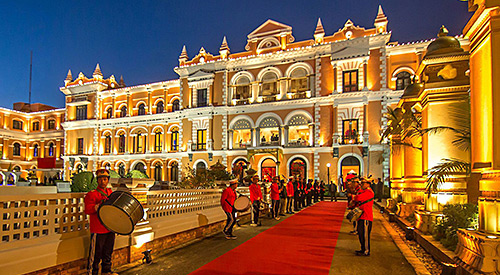
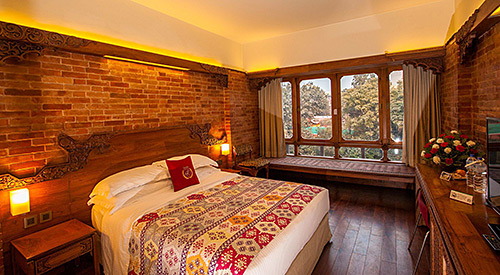
Hotel Yak & Yeti The Yak and Yeti is a heritage hotel located in Durbar Marg, the thriving city center of Kathmandu Valley, in a prime location that is minutes walking distance from the former Royal Palace. Durbar Marg is a commercial area with high-end shops and a variety of food options. This 5 star deluxe luxury property is 6 KM away from the Tribhuvan International Airport, about 1 KM from the famous tourist hub of Nepal- Thamel.
Day 2: Flight to Lukla (9000 feet/2743 m)
After breakfast, we will catch a 20 minute but exciting flight to Lukla. Weather permitting, we should have excellent views of the Himalayan Range. On arrival, we will check in at the Summit Lodge Lukla. After an early lunch, we’ll take a walk up Bom Danda (approx. 3000m) to its village as a way to acclimatize and prepare for the days ahead. Walking along, you get very good views of Lukla and its airfield. We’ll return to the lodge for dinner and overnight.
Accommodations
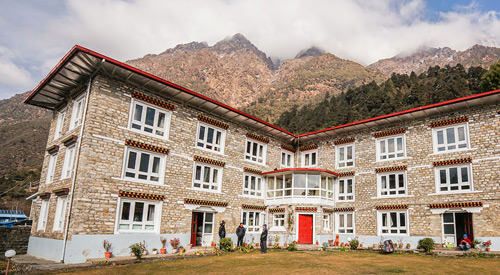
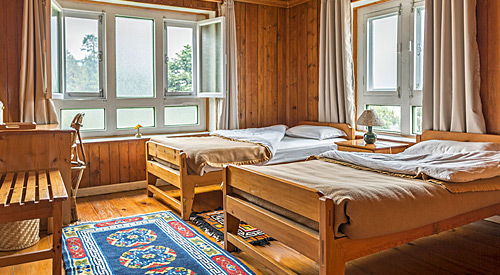
Everest Summit Lodge, Lukla Located at an altitude of 2,860 meters (9,383 feet), Lukla offers a captivating blend of natural beauty and rich cultural heritage. Surrounded by towering Himalayan peaks, including the iconic Mount Everest, the village presents a breathtaking panorama that captures the imagination of all who visit.
Lukla serves as a vital staging point for trekkers and climbers embarking on their Everest expeditions. The village is teeming with mountaineering gear shops and trekking agencies, providing essential services and accommodations for adventurers of all levels. It’s a bustling hub of excitement and anticipation as hikers prepare to undertake the famous Everest Base Camp trek.
Our lodge is situated right next to the famous Tenzing Hillary Airport and with a stunning garden behind the lodge, we will enjoy breakfast in the garden, drenched in the alpine sunshine. This property has 20 rooms and is the perfect place to start or end our trek because of how comfortable our stay will be.
Day 3: Trek to Monjo, (5-6 hours)
An early breakfast and start is planned to avoid the rush of trekkers and porters arriving from Kathmandu. Passing by lovely Sherpa settlements, along gentle undulating trails and enjoying the marvellous scenery of the Dudh Kosi valley, we arrive at the village of Phakding (8700’/2652m). After a break for lunch, we continue on for approximately three more hours to Monjo. The sounds of plodding porters with transistor radios stuck to their ears, the cacophonous mix of languages, strange sounding birds, the sight of porters, loads aside, resting outside tea houses, weather-beaten, windblown trekkers winding their way back to Lukla, prayer flag a-flutter, the brightly painted tea houses and of course the dramatic scenery are memories to treasure of this first day on the trail.
Accommodations
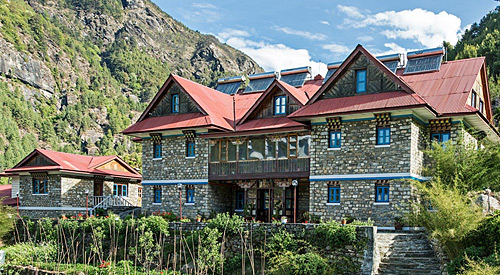
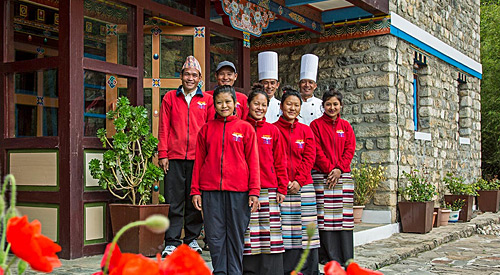
Everest Summit Lodge, Monjo After the first day’s trek from Lukla, Everest Summit Lodge at Monjo is the absolute best place to put our feet up under the warmth of a blanket, sipping on hot tea as we acclimatize ourselves to the trails of Everest. Overlooking the quaint village and the fierce Dudh Koshi River, the lodge is located against the striking backdrop of Thamserku Himal, rising from between the Khumbu and Hinku valley.
Day 4: Trek to Namche Bazaar (11, 300’/3445m), 3-4 hours
A principal benefit of walking as far as Monjo on the second day is that we can walk up the steep hill to Namche fresh in the early morning. We’ll leave Monjo and continue to the park gates of the Sagarmartha National Park at Jorsale where we complete entry formalities. Walking alongside the river we’ll arrive at the confluence of the Imja Drangka and the Nangpo Drangpo, which combine to form the Dudh Khosi. Crossing the river on a high bridge we start the steep climb to Namche. Near the halfway point up the hill, if the sky is clear, your first views of Everest and Lhotse come into sight. We then continue the climb, less steeply now, to Namche, the largest and most prosperous village in the Khumbu.
Thamserku (6,618m) and Kwangde (6,224m) loom to the east and west and the sacred mountain Khumbila (5,707m) dominates the skyline to the north behind the village. The narrow streets at its centre are a mixture of traditional and modern, with Sherpa homes mingled with cafes, handicrafts and shops selling or renting trekking and climbing equipment, foodstuffs and vegetables, tennis shoes and Tibetan boots. Don’t be surprised if, after the exertion of the climb and the rise in elevation, you feel a little tired and head-achey. You will feel better after a cup of tea and a rest.
Accommodations
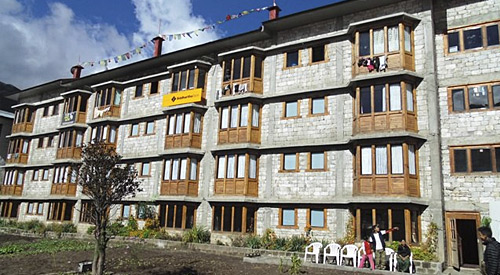
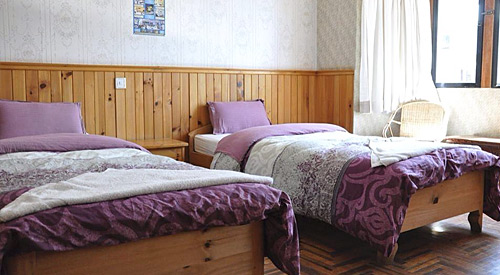
Hotel Namche Hotel Namche features shops, a convenience store and restaurant, which has made this a popular choice among travellers visiting Namche Bazaar. It offers a charming setting with an array of amenities designed for comfort and convenience.
Day 5: Trek to Tashinga (3450m /11,023ft), 5 hours
We’ll have some time in the morning to visit the Sagarmatha National Park Visitors Center and Museum, where there are terrific views of the Everest region and numerous educational displays on the culture, geography, geology, climatology, and wildlife within the park and the Khumbu. This is a great way to kick-off the cultural experience!
We will slowly ascend to the village of Khumjung where will see an extremely ugly, Alcatraz-like building, that offers really superb views from its terrace. We’ll enjoy a cup of tea while looking out at Everest and other Himalayan giants. It might also be possible to visit the clinic in Khunde and the Khumjung school (both projects supported by the Himalayan Trust). The picturesque little gompa in Khumjung, set in a grove of trees above the houses of the village, is also well worth a visit. On payment of a small donation to the caretaker we may be allowed to see the so-called head of a yeti which is kept there. The trail descends from Khumjung with chortens forming a dramatic frame to a view of Ama Dablam (6,696m), and Kangtaiga (6,779m), flanked by the towering heights of Everest, Lhotse and Nuptse. We’ll descend from the village, first through walled fields and then through rhododendron and blue pine forest, to the village of Tashinga.
Accommodations
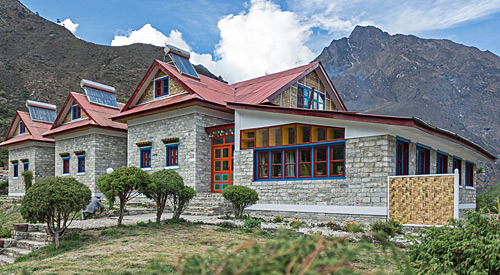
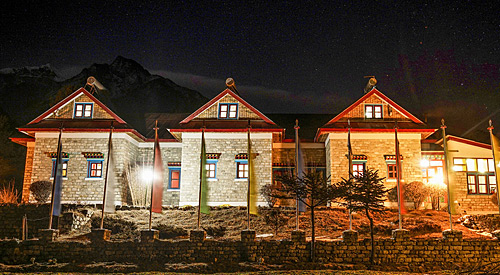
Everest Summit Lodge, Tashinga Everest Summit Lodge at Tashinga is located in a breathtaking, almost uninhabited village, off the main trail to Everest Base Camp and Ama Dablam Base Camp. The lodge is situated amongst pine forest, from where you can gaze endlessly at panoramic views of famous mountains like Ama Dablam, Kangtega, Thamserku and other Himalayan giants. The lodge is newly renovated and offers the highest standard of service and hospitality in the area.
Day 6: Trek to Tengboche and on to Pangboche (3,860m/12,665ft), 4-5 hours
This morning, looking across the valley, we will be able to see the path sloping diagonally up towards the famous monastery of Tengboche, but first we have to descend to the river. This takes half an hour to an hour, descending steeply in a series of zig-zags to the Dudh Kosi River. Here, we cross a suspension bridge in the lee of a gigantic overhanging cliff (3,200m/10,499ft). A little further on is the small hamlet, Phunki Tenga, where we can stop for a cup of tea. It is 2-3 hours from the bridge to reach the monastery at a slow, even pace. At first, we climb steeply up through a pine forest, thankfully in the shade, and then emerge to walk up a long gentle straight path that rises like a ramp to the monastery.
Emerging at the top, there is a mandala gateway and a huge chorten, which we pass before our first sight of the gompa. The setting is nothing short of magic and it is incredible to think that the temple was burnt down only a few years ago and was re-built largely through the efforts of the Sir Edmund Hillary Trust. There is a very good Visitors Centre and in the afternoon it is possible to sit down inside the temple for afternoon prayers. Conch shells are blown, the monks arrive and visitors are expected to sit quietly on the right hand side of the temple. A small donation is appreciated.
Leaving Tengboche, our path descends through trees to Deboche, where the small and atmospheric nunnery is well worth a visit. We’ll pass further houses and ‘mani’ walls as the trail continues along the river valley amongst the trees. After crossing a bridge over a picturesque gorge, the path gradually climbs, with stunning views of Ama Dablam ahead. There are numerous photo opportunities in both directions and frequent chortens to pass as height is gained to reach the village of Pangboche.
Accommodations
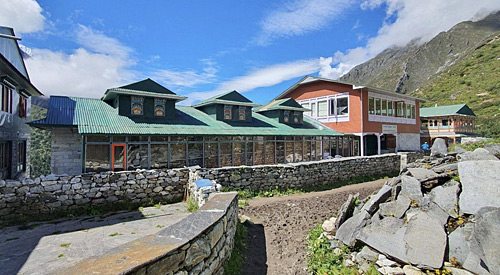
Shreedewa Lodge Pangboche With mountain views, Shreedewa Lodge, is located in Khumjung and has a restaurant, room service, bar and garden. While certainly not fancy, we’ll have private rooms with bathrooms and comfortable amenities.
Day 7: Acclimatization hike to Ama Dablam Base Camp (4,576m/15,014ft), 6-7 hours
Ama Dablam (6,812m /22,349ft) is one of the most loved and admired mountains in Khumbu. After crossing the Imja Drangka river, followed by a gradual ascent until Lhabarma, you are suddenly standing right in front of the mountain ridge. Ama Dablam Base Camp sits at 4,576m/15,013ft on an open yak pasture beneath the west face, with the summit some 2,300m almost straight up above. The climbing route follows the south-west ridge – the right hand skyline as you look at it – moving onto the face above the hanging glacier three-quarters of the way up. This base camp affords particularly fine views of Kan Tega (6,783m/22,254ft), Thamserku (6,618m/21,712ft) and Tawoche (6,542m/21,463ft). With binoculars it may be possible to see climbers descending the 50/60 degree ice-slopes from the summit. In 1998 an Austrian paraglided off the summit reaching base camp in under 10 minutes – substantially quicker than the normal 2-day descent! Return to Pangboche.
Accommodations
Shreedewa Lodge Pangboche
Day 8: Trek to Pheriche (4,360m/14,305ft)
We leave Pangboche on a path which ascends above the village with the sparse landscape now reflecting the height. We’ll pass some yak herders’ cottages and walled fields at Orsho before crossing a stream and making a final steep ascent to Pheriche. The village of Pheriche is set in a stunning location, surrounded by high peaks. In summer months, they grow barley here – possibly the highest altitude in the world at which this crop is grown. Depending on the time you arrive here, and your energy levels, there may be time for an optional afternoon walk.
Accommodations
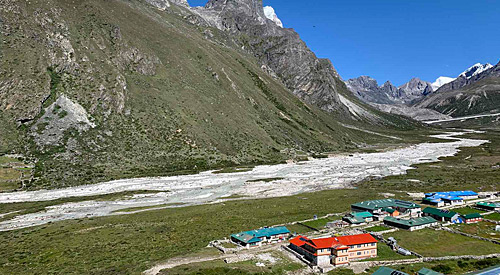
Edelweiss Lodge or similar
Day 9: Trek to Lobuche (16,174ft/4,931m/), 5-6 hours
This morning, we ascend the ridge to a large chorten above Dingboche village and an easy walk up a wide, grassy plateau. The peaks of Tawoche and Cholatse tower above us and it is possible to see Pheriche village in the valley below to our left. At the tiny hamlet of Duglha, we’ll reach a jumble of rocks which marks the terminal moraine at the base of the Khumbu Glacier. We ascend steeply up this moraine to reach the top where there are many memorial cairns to those who have died on Everest. The landscape is now wild and rocky and there is a real feeling of being high in the mountains. Following the often frozen stream at one side of the moraine you soon reach the cluster of houses at Lobuche. This rather bleak spot was once a yak grazing settlement inhabited only during the summer months but now it is open throughout the winter serving trekkers and climbers as the jumping off point for Everest Base Camp and Kalar Pattar. Sunset over Nuptse is particularly spectacular from here. It is worth walking over to the moraine to view the glacier behind it.
Accommodations
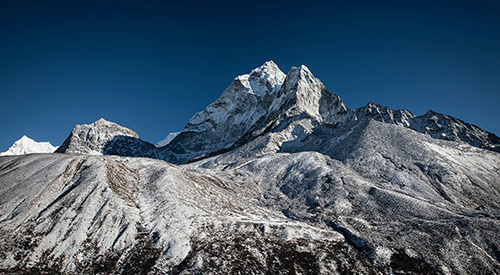
Himalayan Eco Lodge or Similar
Day 10: Trek To Everest Base Camp (5,300m/17,388ft) Return to Gorak Shep (5,165m/16,945ft), 6-7 hours
This is the big day for the trek to Base Camp. An early start is essential to get there before any cloud comes down and it will probably be very cold when we set off. Today, make sure to have something for breakfast even if you don’t feel like it as you will need the energy. We are at high altitude so we’ll take some snacks to keep us going along the way and be sure to have our water bottles filled when we set off.
Leaving Lobuche, we head north-east, along the side of the Khumbu Glacier through jumbled moraine and shattered rock. There is almost no vegetation here. Even so, small coveys of the delightful Tibetan Snow Cock can often be seen along the way or heard calling from the hillsides. We’ll make several energetic ups and downs across the moraine and descend to Gorak Shep for a reviving cup of tea and a snack.
From Gorak Shep it is still a long, fairly arduous trek to base camp, initially following the top of the moraine and then descending onto the boulder-strewn glacier. After a couple of hours we reach the base camp area from where, although you do not have views of the actual summit of Everest, there are sensational close-up views of the terrifying Khumbu ice-fall and the surrounding scenery of seracs and tumbled rocks. At this altitude, the return to Gorak Shep will feel like quite a long way and will use up your remaining reserves of energy.
Accommodations
Snowland Inn or Similar
Day 11: Ascend Kala Pattar (5,545m/18,192ft) to Pheriche (4,371m/14,340ft), 7 hours
At Gorak Shep, we are poised for an ascent of Kala Pattar in the clear of the morning before cloud comes in to obscure the summit of Everest. This is a tough, but not long, ascent of approximately 2-3 hours and reaches the rocky summit of Kala Pattar at 5,545m – quite literally the high-point of your trek. From the summit of Kala Pattar there are great views of the summit of Everest as well as other Himalayan giants – Pumori (7,145m), the Tibetan peak Changtse (4,501m), Nuptse, Lhotse and countless other needles and snow fluted ridges. We can also look down on the Khumbu Glacier where base camp is located during the climbing season in late spring. We will then descend to Gorak Shep and take the trail back down to Lobuche. From Lobuche we follow the path down as far as Dughla and then instead of taking the trail back to Dingboche, we descend to the flat valley bottom. It’s a short distance on the flats to reach Pheriche where we will stay for the night.
Accommodations
Edelweiss Lodge or similar
Day 12: Trek to Tashinga (3,450m /11,023ft), 6-7 hours
This morning will seem much easier as we are descending at a lower altitude than you have been at for the last five days. From Pheriche we descend to join the valley of the Imja Khola and retrace our steps past Orsho and down the pleasant trail to Pangboche. If we did not have a chance to visit the gompa in Pangboche on the way up it would be worth a quick visit now. Leaving Pangboche we descend and cross a bridge over a terrifying gorge before making a short climb in forest to Thyangboche. From Thyangboche we descend to the river at Phungithanga and then make the final climb of the day up through pine forest to reach the Tibetan traders at Tashinga. It will seem delightfully warm at this altitude and the air positively packed with oxygen!!
Accommodations
Everest Summit Lodge, Tashinga
Day 13: Trek To Monjo (2,850m/9,301ft), 5-6 hours
From Kyanjuma, we will take a delightful undulating trail with some of our last high altitude mountain views of the trek looking across to the summits of Thamserkhu and Kangtaiga. We descend into Namche and have time to enjoy a bit of souvenir shopping at the market, before making the knee crunching descent back down to the valley. Market day in Namche is a very important event for the people of the Khumbu. In the days before the market the trail up from the lowlands is busy with porters carrying supplies –everything from rice, eggs and beer to trainers, saucepans and CDs. Then on Saturday, sherpas from all the villages around flock to Namche to do their shopping and also to restock the tea houses. The warmer climate should offer us a good opportunity to finally shed a layer or two. We will still have wonderful views and the chance to relax in slightly warmer valley surroundings. We’ll trek back down the Dudh Kosi valley past the checkpoint at Jorsale to Monjo.
Accommodations
Everest Summit Lodge, Monjo
Day 14: Trek To Lukla (2,804m/9,336ft), 5 to 6 hours
Most people head towards Lukla with a heavy heart. There is something very special about the setting, the villages and the people of the high Khumbu hills and valleys and these memories will help you up the deceptively long, final climb into Lukla. The trail to Lukla follows the main trail as far as Chablung, and then turns off above the village of Chaunrikharka towards Lukla. There are signs beyond the stream at Chablung pointing you in the direction of Lukla. The broad trail, leading uphill to the left, climbs steadily past a few bhattis and the school, then through scrub forests above the school and houses of Chaunrikharka. After a steep final climb there is a collection of houses and bhattis in Tamang Tole, a new settlement a short distance from the airport. As we approach the airstrip the houses and hotels rapidly proliferate. On arrival we can finally relax and enjoy a celebratory beer.
Accommodations
Everest Summit Lodge, Lukla
Day 15: Today we leave the mountains behind and fly back to Kathmandu.
Please note: that these flights are sometimes delayed due to weather conditions (either in fog-bound Kathmandu or wind in Lukla). Be assured that our support staff in Lukla and Kathmandu will be doing everything possible to minimize the inconvenience caused if this happens. Your patience in the these trying circumstances, which can occur, will be greatly appreciated. Our final day of leisure planned in Kathmandu does provide a valuable ‘cushion’ against missing your flight home, should the Lukla flight be delayed.
On arrival in Kathmandu you will be met and transferred to the Hotel Yak & Yeti.
Accommodations
Hotel Yak & Yeti
Day 16: Kathmandu
Today, assuming our flight got out of Lukla on time, gives us time to relax and reflect on our adventure. In the late morning, we have a half-day guided sightseeing tour planned to visit Boudnath Stupa then Pashupatinath Temple, which are the two most important Buddhist and Hindu places of worship.
The afternoon is at your leisure and you may wish to do some last-minute souvenir shopping. Tonight we’ll gather for our farewell dinner and toast to an exciting adventure!
Accommodations
Hotel Yak & Yeti
Day 17: Departure Day
Today you will be transferred to the airport for flights home.
Trek Leaders
This trek will be led by professionally trained local guides. They have an intimate and expert knowledge of the trekking regions of Nepal and will make your trek a memorable experience.
You will be hiking 6-7 hours a day, mostly at elevations above 12,000 feet. The trails can be difficult and this type of terrain, combined with the altitude, will make it a challenging experience. You need to be in good physical condition and have previous experience hiking and ideally sleeping at high altitudes. While this itinerary has been carefully designed to optimize acclimatization to high altitudes, participants on this trip are likely to experience some symptoms of being at altitude.
Climate
Temperatures in the Everest region are quite cool after sundown but due to the strong direct sunlight at high altitudes, very warm during the day. If the weather is good you will certainly be trekking in a t-shirt and long shorts or light trekking trousers, and sun hat. The monsoon traditionally arrives around mid-June and clears away by the end of September leaving clear skies, warm or even hot temperatures during the day and cooler ones by night. Temperatures steadily decrease as you proceed towards the end of December and it can be cold on the trail – particularly at night and at altitude.
Your Accommodations
The Everest Summit Lodges we use surpass anything else in the Everest region in terms of quality and have the very definite advantage of en suite bathrooms and flush toilets for all bedrooms. Rooms are not heated but supplemented by electric blanket where electricity is available or by hot water bottles. Common area are heated. To protect the fragile eco system they do not sell packaged water, but have water filters to fill your water bottles. Meals are three courses with soup, main course and dessert, Tea and coffee is served free at the lodges.
In Namche Bazaar we plan to use the Namche Hotel. These typical trekking “comfort lodges” are conveniently situated, have electricity, good food, en-suite bathrooms, and bedding is provided.
In Pheriche, Lobuche and Gorak Shep you will stay in tea houses. These are more basic than the ‘comfort lodges’ although they still have twin-bedded rooms and plentiful good food. Sleeping bags will be provided for these nights. Please note: on DAY 9 and DAY 10 the lodges are very basic in nature with shared toilets and no showers, but the rooms will be private (based on double occupancy.


